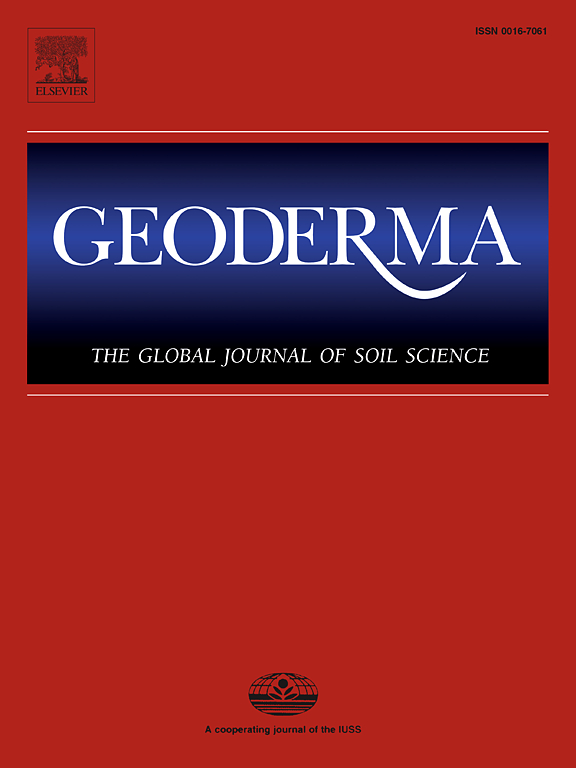地中海农田底土中高碳生物降解性的证据
IF 6.6
1区 农林科学
Q1 SOIL SCIENCE
引用次数: 0
摘要
虽然土壤碳是土壤健康和减缓气候变化的关键因素,但我们对其动态的理解仍然不完整。人们认为,深层土壤层中含有的大部分有机碳在百年甚至千年的时间尺度上保持稳定。本研究旨在探讨半干旱地中海栽培环境深层土壤碳高稳定性的共同范式。对突尼斯东北部11个土壤剖面的土壤有机碳(SOC)含量、储量、生物降解性和放射性碳年龄进行了综合评价和分析,研究对象为极低至中等含量土壤无机碳(SIC)含量的海相沉积母质土壤。土壤有机碳含量和储量是地中海栽培土壤的典型特征,土壤有机碳含量低(约2%),随土壤深度的增加而降低,土壤有机碳储量主要分布在地下(约30 cm)。我们的研究结果首先揭示了所有被调查土壤的高水平碳生物降解性,证实了地中海环境下的土壤碳可以在最佳温度和湿度条件下快速分解。他们还表明,碳的生物降解性随着深度的增加而增加,即使在SIC含量非常低的剖面中也是如此,这表明底土碳的有机组分可能不如表土碳的有机组分稳定。利用基于文献的碳源CO2对土壤呼吸排放的贡献校正,支持了有机碳可生物降解性随深度的显著增加。土壤有机碳可降解性与其放射性碳年龄呈显著正相关,表明土壤有机碳稳定性随平均停留时间的增加而降低。我们通过在地下有机碳库中大量存在非常古老且高度可生物降解的有机碳来解释这些原始结果,这些有机碳可能继承自第四纪古环境,并由于与半干旱气候相关的有利保存条件而保存至今。最后,这项研究强调了储存在地中海土壤深处的几千年历史的有机碳库的巨大脆弱性,以及保护它不与大气重新连接的必要性。更广泛地说,它表明需要在这些特定环境的碳循环研究中更多地考虑旧有机碳的积极作用。本文章由计算机程序翻译,如有差异,请以英文原文为准。
Evidence of high carbon biodegradability in the subsoil of Mediterranean croplands
Although soil carbon is a key element for soil health and climate change mitigation, our understanding of its dynamics is still incomplete. Deep soil horizons are thought to contain mostly organic carbon stabilised at centennial or even millennia time scales. The present study aimed to investigate the common paradigm of high stability of soil carbon in deep soil horizons in semiarid Mediterranean cultivated environments. It was based on a combined assessment and analysis of soil organic carbon (SOC) contents, stocks, biodegradability, and radiocarbon age of eleven soil profiles in north-eastern Tunisia, in the context of soils developed on marine sedimentary parent material with very low to moderate soil inorganic carbon (SIC) content. SOC content and stocks were found to be typical of cultivated Mediterranean soils, with low SOC content (<2%), decreasing with depth and a predominant stock of SOC in subsoils (>30 cm). Our results first revealed high levels of carbon biodegradability for all the soils investigated, confirming that soil carbon in the Mediterranean context can be rapidly decomposed under optimal temperature and moisture conditions. They also showed that the biodegradability of carbon increased with depth, even in profiles with very low SIC contents, indicating that the organic fraction of subsoil carbon is likely to be less stable than that of topsoil carbon. The significant increase in SOC biodegradability with depth was supported by applying a literature-based correction for the contribution of SIC-derived CO2 to soil respiration emissions. In addition, SOC biodegradability was strongly positively correlated with its radiocarbon age, implying that SOC stability decreases with increasing mean residence time. We explained these original results by a significant presence of very old and highly biodegradable organic carbon in the subsoil organic carbon pool, probably inherited from a Quaternary paleoenvironment and preserved since then due to the favourable preservation conditions associated with the semi-arid climate. Finally, this study highlights the great vulnerability of the millennia-old organic carbon pool stored in some deep horizons of Mediterranean soils, and the necessity to protect it from reconnection with the atmosphere. More broadly, it demonstrates the need to take greater account of the active role of old organic carbon in carbon cycle studies in these specific environments.
求助全文
通过发布文献求助,成功后即可免费获取论文全文。
去求助
来源期刊

Geoderma
农林科学-土壤科学
CiteScore
11.80
自引率
6.60%
发文量
597
审稿时长
58 days
期刊介绍:
Geoderma - the global journal of soil science - welcomes authors, readers and soil research from all parts of the world, encourages worldwide soil studies, and embraces all aspects of soil science and its associated pedagogy. The journal particularly welcomes interdisciplinary work focusing on dynamic soil processes and functions across space and time.
 求助内容:
求助内容: 应助结果提醒方式:
应助结果提醒方式:


